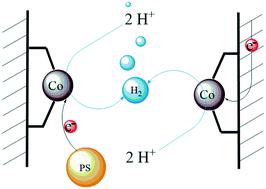当前位置:
X-MOL 学术
›
Catal. Sci. Technol.
›
论文详情
Our official English website, www.x-mol.net, welcomes your
feedback! (Note: you will need to create a separate account there.)
Mechanistic insights into photocatalysis and over two days of stable H2 generation in electrocatalysis by a molecular cobalt catalyst immobilized on TiO2
Catalysis Science & Technology ( IF 4.4 ) Pub Date : 2020-04-02 , DOI: 10.1039/d0cy00330a Nicola Weder 1, 2, 3, 4 , Benjamin Probst 1, 2, 3, 4 , Laurent Sévery 1, 2, 3, 4 , Ricardo J. Fernández-Terán 1, 2, 3, 4 , Jan Beckord 2, 3, 4, 5 , Olivier Blacque 1, 2, 3, 4 , S. David Tilley 1, 2, 3, 4 , Peter Hamm 1, 2, 3, 4 , Jürg Osterwalder 2, 3, 4, 5 , Roger Alberto 1, 2, 3, 4
Catalysis Science & Technology ( IF 4.4 ) Pub Date : 2020-04-02 , DOI: 10.1039/d0cy00330a Nicola Weder 1, 2, 3, 4 , Benjamin Probst 1, 2, 3, 4 , Laurent Sévery 1, 2, 3, 4 , Ricardo J. Fernández-Terán 1, 2, 3, 4 , Jan Beckord 2, 3, 4, 5 , Olivier Blacque 1, 2, 3, 4 , S. David Tilley 1, 2, 3, 4 , Peter Hamm 1, 2, 3, 4 , Jürg Osterwalder 2, 3, 4, 5 , Roger Alberto 1, 2, 3, 4
Affiliation

|
To employ molecular water reduction catalysts (WRC) in a heterogeneous setup, a stable, macrocyclic CoIII–polypyridyl WRC containing two phosphonic acid groups was anchored on TiO2 to investigate photo- and electrocatalytic proton reduction. Photocatalytic investigations included kinetic studies of the electron transfer from the reduced photosensitizer to the WRC as well as H2-evolution measurements. Linear sweep voltammetry (LSV) performed on the immobilized WRC on a TiO2-coated FTO-glass electrode showed an onset potential of −0.6 V vs. SHE at pH = 5 for proton reduction, while operando UV/VIS confirmed the reduced CoI-species as the key catalytic intermediate. Finally, chronoamperometric investigations combined with XPS studies and ICP-MS studies of electrode and electrolyte revealed stable binding of the WRC on the electrode under catalytic conditions and constant H2-formation over the period of two days.
中文翻译:

固定在TiO2上的分子钴催化剂对光催化的机理见解以及在两天内稳定产生H2的电催化作用
为了在非均相设置中使用分子减水催化剂(WRC),将包含两个膦酸基团的稳定的大环Co III-聚吡啶基WRC固定在TiO 2上,以研究光催化和电催化质子还原。光催化研究包括从还原型光敏剂到WRC的电子转移的动力学研究以及H 2演化测量。在二氧化钛上的固定化WRC进行线性扫描伏安法(LSV)2涂覆的FTO玻璃电极显示出-0.6 V时开始电位相对于SHE在质子还原的pH = 5,而operando UV / VIS证实还原的Co我种作为主要的催化中间体。最后,计时电流分析与XPS研究和ICP-MS对电极和电解质的研究相结合,揭示了WRC在催化条件下在电极上的稳定结合以及在两天内恒定的H 2形成。
更新日期:2020-04-02
中文翻译:

固定在TiO2上的分子钴催化剂对光催化的机理见解以及在两天内稳定产生H2的电催化作用
为了在非均相设置中使用分子减水催化剂(WRC),将包含两个膦酸基团的稳定的大环Co III-聚吡啶基WRC固定在TiO 2上,以研究光催化和电催化质子还原。光催化研究包括从还原型光敏剂到WRC的电子转移的动力学研究以及H 2演化测量。在二氧化钛上的固定化WRC进行线性扫描伏安法(LSV)2涂覆的FTO玻璃电极显示出-0.6 V时开始电位相对于SHE在质子还原的pH = 5,而operando UV / VIS证实还原的Co我种作为主要的催化中间体。最后,计时电流分析与XPS研究和ICP-MS对电极和电解质的研究相结合,揭示了WRC在催化条件下在电极上的稳定结合以及在两天内恒定的H 2形成。









































 京公网安备 11010802027423号
京公网安备 11010802027423号